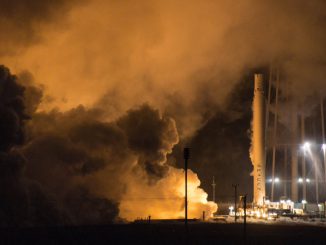The Sentinel-6 Michael Freilich satellite — named for the former head of NASA’s Earth science division who died of cancer earlier this year — is affixed to the top of the 229-foot-tall (70-meter) Falcon 9 rocket awaiting liftoff from the Central Coast of California at 12:17:08 p.m. EST (9:17:08 a.m. PST; 1717:08 GMT) Saturday.
The satellite was built by Airbus in Germany and is the size of a small pickup truck. Sentinel-6 Michael Freilich carries a radar altimeter, a microwave radiometer, and instruments to precisely locate the satellite in orbit. Working together, the instruments will track changes in sea level down to a few centimeters.
Rising sea levels are one consequence of climate change, and predecessor satellites show the rate of sea level rise is accelerating, according to mission scientists.
Sentinel-6 Michael Freilich is the next in a series of oceanography missions tracking sea level rise, beginning with the U.S.-French Topex/Poseidon mission that launched in 1992. The Jason 1, Jason 2, and Jason 3 satellites followed Topex/Poseidon, and an identical satellite to Sentinel-6 Michael Freilich named Sentinel-6B is planned for launch in 2025 to further extend the data record of sea level rise.
The mission was developed in a partnership between NASA, the European Space Agency, Eumetsat, and NOAA, along with support from the European Commission and the French space agency CNES.
Working under a $97 million contract with NASA, SpaceX is poised to launch the 2,628-pound (1,192-kilogram) Sentinel-6 Michael Freilich spacecraft from Vandenberg Air Force Base into a 830-mile-high (1,336-kilometer) orbit.
The Falcon 9 rocket — flying with a brand new first stage — will head south-southeast from Vandenberg to place the Sentinel-6 Michael Freilich satellite into an orbit tilted 66 degrees to the equator.
After two burns of the rocket’s second stage, the Falcon 9 is set to deploy the spacecraft around 53 minutes into the mission.
SpaceX plans to propulsively land the Falcon 9’s first stage booster back at Vandenberg on Landing Zone 4, just west of the rocket’s launch pad on a hillside overlooking the Pacific Ocean.
These photos show the encapsulation of the Sentinel-6 Michael Freilich satellite inside the Falcon 9 rocket’s payload shroud at Vandenberg.








Email the author.
Follow Stephen Clark on Twitter: @StephenClark1.



